#cretoxyrhina
Explore tagged Tumblr posts
Text




cretoxyrhina, barinasuchus, clidastes, hypuronector
#my art#paleoart#paleostream#flocking#cretoxyrhina#barinasuchus#clidastes#hypuronector#drepanosaur#shark#mosasaur
297 notes
·
View notes
Text




Flocking doodles
Cretoxyrhina drowning a Pteranodon
Barinasuchus walking around at night
Clidastes preying on a flock of Hesperornis
Hypuronector doing a mating display
#paleostream#paleoart#Cretoxyrhina#Pteranodon#Barinasuchus#Clidastes#Hesperornis#Hypuronector#shark#pterosaur#crocodile#mosasaur#lizard#birds#fish
218 notes
·
View notes
Text
#Paleostream 13/07/2024
here's today's #Paleostream sketches!!! today we drew Cretoxyrhina, Barinasuchus, Clidastes, Hypuronector




#Paleostream#paleoart#paleontology#digital art#artists on tumblr#digital artwork#palaeoart#digital illustration#sciart#id in alt text#palaeoblr#paleoblr#shark#shark week#shark art#extinct shark#Cretoxyrhina#pseudosuchian#Barinasuchus#mosasaur#marine reptile#extinct reptile#Clidastes#drepanosaur#Hypuronector
130 notes
·
View notes
Text
An unfortunate hadrosaur has been washed out into the western interior seaway, and it's attracting quite the crowd.

#paleoart#paleontology#evolution#dinosaur#dinosaurs#birds#pterosaurs#pterosaur#elasmosaurus#plesiosaur#ichthyornis#shark#sharks#cretoxyrhina#pteranodon#geosternbergia#claosaurus#hadrosaur#hadrosaurs#western interior seaway#niobrara#niobrara formation#north america#cretaceous#mesozoic#animal art#animals#zoology
33 notes
·
View notes
Text

What happens when an angel falls from the sky?
15 notes
·
View notes
Text

Ginsu shark
Cretoxyrhina mantellii
A species of large predatory shark from the late Cretaceous, Cretoxyrhina mantellii (meaning 'Mantel's Cretaceous sharp-nose'), commonly known as the Ginsu shark, fed on medium- to large-sized fish and marine reptiles across the world's oceans. Massive and fast, the Ginsu shark was a top predator in its ecosystem, regularly competing with mosasaurs and other predatory fish in such regions as the Western Interior Seaway.
13 notes
·
View notes
Text

Results from todays flocking
The first sketch was cretoxyrhina, which I could do at the same time as everyone because eating, so I did this while everyone was posting In like uh ten minutes



Then we did
Barinasuchus
Clidastes
Hupuronector
#speculative biology#paleoart#lmao#baby stream#reptile#paleontology#paleostream#flocking#art#really proud of myself#night#gecko#cretoxyrhina#barinasuchus#clidastes#hypuronector#myart#shark#shark week#babies
18 notes
·
View notes
Text

Flocking Together
Cretoxyrhina
Barinasuchus
Clidastes
Hypuronector
#paleoart#prehistory#paleostream#cretoxyrhina#barinasuchus#clidastes#hypuronector#palaeoblr#made with krita
9 notes
·
View notes
Text
The giant shark Cretoxyrhina devours a Clidastes 83 million years ago in what is now the Niobrara Chalk formation of Kansas

14 notes
·
View notes
Text





my hand is hurting a little from drawing stuff for work, so today's flocking sketches are simple and silly. cretoxyrhina (with a pteranodon), barinasuchus, amplectobelua, clidastes and hypuronector
#they all have 0 braincells and so am i after this week#barghestland#art#artists on tumblr#paleoart#paleoland#paleostream flocking
3K notes
·
View notes
Text













SHARKS!!
From their first appearance around 370 million years ago, cartilaginous fishes have been emperors of the oceans. This list does include critters that are more shark-adjacent than true Elasmobranch sharks.
Cladoselache (D) - Xenacanthus (D) - Stethacanthus (D)
Acanthodes (C) - Squatinactus (C) - Falcatus (C)
Helicoprion (P) - Ptychodus (K) - Edestus (C)
Megalodon (Ng)
Hybodus (K) - Frilled Shark (H) - Goblin Shark (H)
Stickers || Phone Wallpapers Masterlist
Planned or in the works: Cretoxyrhina
#art#my art#paleontology#paleoart#science#illustration#shark#megalodon#cladoselache#xenacanthus#stethacanthus#acanthodes#squatinactus#falcatus#helicoprion#ptychodus#edestus#hybodus#frilled shark#goblin shark
75 notes
·
View notes
Text




Doodles from yesterday's flocking paleostream featuring Cretoxyrhina, Barinasuchus, Clidastes, and Hypuronector.
#art#paleostream#paleoart#paleontology#paleoblr#prehistoric#digital illustration#reptile#shark#shark week
91 notes
·
View notes
Text
Archovember 2024 Day 25 - Pteranodon longiceps
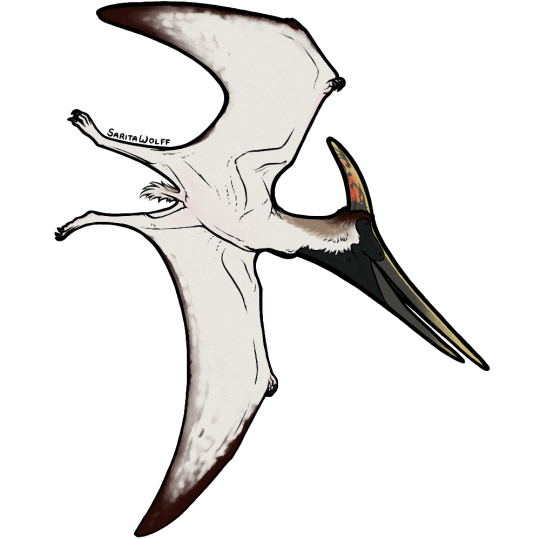
As one of the main species to make up the mythical “Pterodactyl” conglomerate, Pteranodon longiceps is possibly the most familiar pterosaur to the public. However, most people don’t know much about the real animal behind the pop culture monster. Living in the Late Cretaceous USA, Pteranodon is also the most well-known pterosaur to science, as over 1,200 specimens have been found! It was the first pterosaur found outside of Europe, the first toothless pterosaur found, and, before the discovery of the giant azhdarchids, was also the largest pterosaur known. Pteranodon is also one of the few prehistoric animals with confirmed sexual dimorphism, and it’s a bit extreme to boot! The larger male Pteranodons had huge pointed crests and an average wingspan of 5.6 m (18 ft), while the smaller female Pteranodons had small, rounded crests, wider pelvic canals, and an average wingspan of 3.8 m (12 ft).
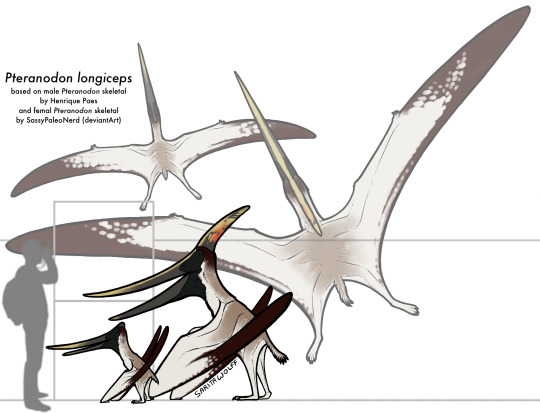
Pteranodon lived around the Western Interior Seaway, a massive sea that split North America in two during the Late Cretaceous into the Early Paleocene. With wings shaped like modern day albatrosses, Pteranodons were likely gliders who relied on thermals, but did seem to be more capable of sustained flapping. As one would expect, their diet was made up mostly of fish, though they may have eaten invertebrates as well. With their more heavy build, they could probably dive into the water like modern day gannets, folding up their wings and plunging beneath the waves, snatching up fish with their pointed, birdlike beaks. Pteranodon crests were most likely for display, as there was variation between not only males and females, but also individual males. As females were twice as common as males, they were probably polygynous, with males competing for the mating rights in rookeries of females. Competition was likely not physical, and instead would depend on females determining the age and fitness of males based on the size of their crest.
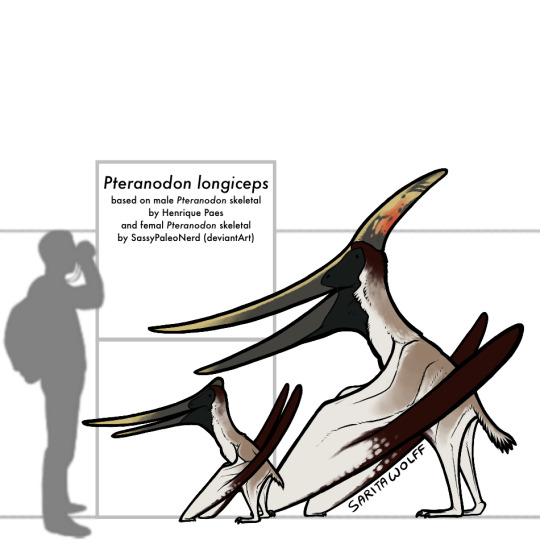
Pteranodon has been found in both the Niobrara Formation and the younger Pierre Shale Formation. Some possible fragments from the Mooreville Formation and Merchantville Formation also exist. While Pteranodon was much more common, it would have lived alongside, and possibly competed with, the fork-crested pterosaur Nyctosaurus and the toothed seabird Ichthyornis. It is probable that Pteranodon lived in offshore rookeries, raising their flaplings far from land-based predators, as most fossils are found far from what would have been the Interior Seaway’s coastline. Under the waves, Pteranodon would have hunted a variety of fish, ammonites, and squid. It would have come across sea turtles such as Toxochelys, plesiosaurs such as Styxosaurus, and flightless birds like Parahesperornis. It would have had to look out for mosasaurs like Tylosaurus and sharks like Cretoxyrhina. Aside from birds, most Pteranodons would rarely come across dinosaurs. Their main exposure to dinosaurs would be corpses, like that of the hadrosaur Claosaurus, being swept out to sea.

This art may be used for educational purposes, with credit, but please contact me first for permission before using my art. I would like to know where and how it is being used. If you don’t have something to add that was not already addressed in this caption, please do not repost this art. Thank you!
#Pteranodon longiceps#Pteranodon#pteranodontid#pterosaurs#archosaurs#archosauromorphs#reptiles#Archovember#Archovember2024#Dinovember#Dinovember2024#SaritaDrawsPalaeo#Late Cretaceous#USA#Niobrara Formation#Pierre Shale Formation#Mooreville Formation#Merchantville Formation
39 notes
·
View notes
Text
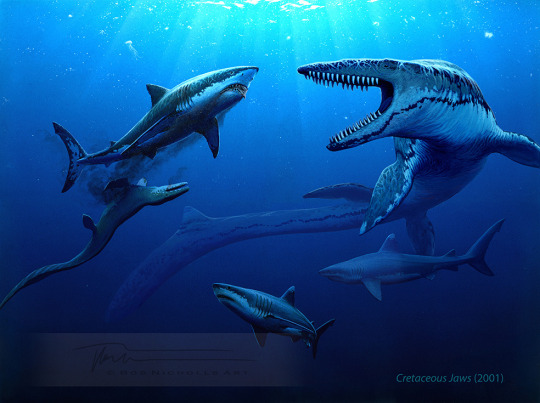
My 25 years of palaeoart chronology...
Here is a larger image of my Cretaceous Jaws painting (acrylic on card), from 2001. Depicted are two Squalicorax, a Cretoxyrhina eating a juvenile Tylosaurus, and an adult tylosaur.
#Art#Painting#PaleoArt#PalaeoArt#SciArt#SciComm#DigitalArt#Illustration#Dinosaurs#Birds#Reptiles#Palaeontology#Paleontology#Sharks#Tylosaurus
109 notes
·
View notes
Text

Cardabiodon ricki
A robust, heavyset shark, Cardabiodon ricki (meaning 'Cardabia tooth of Rick') dominated antitropical seas of the Late Cretaceous. Reaching up to 18 ft (5.5 meters), C. ricki coexisted with predatory marine reptiles like pliosaur Brachauchenius, and other macropredatory sharks, like similarly large-bodied Cretoxyrhina and Cretodus, in the Western Interior Seaway.
4 notes
·
View notes
Photo
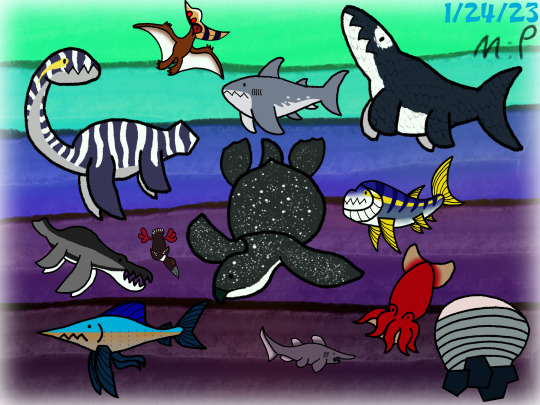
Everyone, do the Niobrara Jive!
#tylosaurus#cretoxyrhina#Geosternbergia#Elasmosaurus#Dolichorhynchops#Protosphyraena#Scapanorhynchus#Inoceramus#Enchoteuthis#Xiphactinus#Archelon#Hesperornis#my artz#Ultra Ramblings#paleoart#paleotology
14 notes
·
View notes